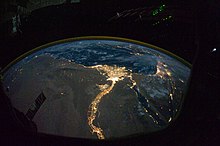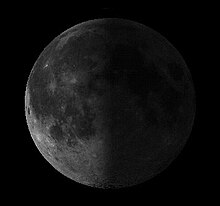| Revision as of 23:10, 15 June 2020 editRandomCanadian (talk | contribs)Extended confirmed users, Pending changes reviewers, Rollbackers36,695 editsm Rollback edit(s) by 2A00:23C5:9585:CD00:C85A:4232:6DCD:CD8C (talk): Vandalism (RedWarn rev14)Tag: Rollback← Previous edit | Revision as of 08:08, 17 June 2020 edit undo68.12.0.207 (talk)No edit summaryTag: Visual editNext edit → | ||
| Line 3: | Line 3: | ||
| ] in the ] at night]] | ] in the ] at night]] | ||
| ⚫ | '''Night''' is not day.] of the ] and ] at night]] | ||
| '''Night''' or '''nighttime''' ('']'' '''night-time''' or '''night time''') is the period of ambient darkness from ] to ] in each twenty-four hours,<ref>{{cite web|url=https://en.oxforddictionaries.com/definition/night|title=night - Definition of night in English by Oxford Dictionaries|website=Oxford Dictionaries - English}}</ref> when the ] is below the ]. The exact time when night begins and ends (equally true with ]) depends on the location and varies throughout the year.<ref>{{cite web|url=https://www.timeanddate.com/sun/uk/london|title=Sunrise and sunset times in London|website=www.timeanddate.com}}</ref> When night is considered as a period that which follows evening, it is usually considered to start around 9 pm and to last to about 4 am.<ref>{{cite web|url=http://www.learnersdictionary.com/qa/parts-of-the-day-early-morning-late-morning-etc|title=Parts of the Day: Early morning, late morning, etc. - Ask The Editor - Learner's Dictionary|website=www.learnersdictionary.com}}</ref> Night ends with coming of ] at sunrise.<ref>Online Dictionary Definitions of "morning" | |||
| * | |||
| * | |||
| * | |||
| *</ref> | |||
| The word can be used in a different sense as the time between bedtime and ].<ref>{{cite web|url=https://www.dictionary.com/browse/night|title=the definition of night|website=www.dictionary.com}}</ref> In common communication the word 'night' is used as a farewell ('good night') and sometimes shortened to 'night', mainly when someone is going to sleep or leaving.<ref>{{Cite web|url=https://www.merriam-webster.com/dictionary/good+night|title=Definition of GOOD NIGHT|website=www.merriam-webster.com|language=en|access-date=2019-12-31}}</ref> For example: ''It was nice to see you. Good night!''{{cn|date=January 2020}} Unlike 'good ],' 'good ],' and 'good ],' 'good night' (or 'goodnight') is not used as a ]. | |||
| '''Complete darkness''' or '''astronomical night''' is the period between astronomical ] and astronomical ] when the Sun is between 18 and 90 degrees below the horizon and does not illuminate the sky. As seen from ]s between 48.5607189° and 65.7273855666...° north or south of the ], complete darkness does not occur around the ] because although the Sun sets, it is never more than 18° below the horizon at lower ]. | |||
| The opposite of night is ] (or "]", to distinguish it from "day" referring to a 24-hour period). The start and end points of time for a night vary, based on factors such as ] and ]. ] is the period of night after sunset or before sunrise when the Sun still illuminates the sky when it is below the horizon. At any given time, one side of ] is bathed in ] (the daytime) while the other side is in ] caused by Earth blocking the sunlight. The central part of the shadow is called the ]. | |||
| Natural illumination at night is still provided by a combination of ], ], ], ], ], and ]. In some circumstances, ]e, ], and ] can provide some illumination. The ] provided by artificial lighting is sometimes referred to as ] because it can interfere with ] and ]s. | |||
| ==Duration and geography== | |||
| ⚫ | ] of the ] and ] at night]] | ||
| On Earth, an average night lasts shorter than ] due to two factors. Firstly, the ]'s apparent disk is not a point, but has an ] of about 32 ]s (32'). Secondly, the ] sunlight so that some of it reaches the ground when the Sun is below the horizon by about 34'. The combination of these two factors means that light reaches the ground when the center of the solar disk is below the ] by about 50'. Without these effects, daytime and night would be the same length on both ]es, the moments when the Sun appears to contact the ]. On the equinoxes, daytime actually lasts almost 14 minutes longer than night does at the ], and even longer towards the ]s. | On Earth, an average night lasts shorter than ] due to two factors. Firstly, the ]'s apparent disk is not a point, but has an ] of about 32 ]s (32'). Secondly, the ] sunlight so that some of it reaches the ground when the Sun is below the horizon by about 34'. The combination of these two factors means that light reaches the ground when the center of the solar disk is below the ] by about 50'. Without these effects, daytime and night would be the same length on both ]es, the moments when the Sun appears to contact the ]. On the equinoxes, daytime actually lasts almost 14 minutes longer than night does at the ], and even longer towards the ]s. | ||
Revision as of 08:08, 17 June 2020
For other uses, see Night (disambiguation).

Night is not day.

On Earth, an average night lasts shorter than daytime due to two factors. Firstly, the Sun's apparent disk is not a point, but has an angular diameter of about 32 arcminutes (32'). Secondly, the atmosphere refracts sunlight so that some of it reaches the ground when the Sun is below the horizon by about 34'. The combination of these two factors means that light reaches the ground when the center of the solar disk is below the horizon by about 50'. Without these effects, daytime and night would be the same length on both equinoxes, the moments when the Sun appears to contact the celestial equator. On the equinoxes, daytime actually lasts almost 14 minutes longer than night does at the Equator, and even longer towards the poles.
The summer and winter solstices mark the shortest and longest nights, respectively. The closer a location is to either the North Pole or the South Pole, the wider the range of variation in the night's duration. Although daytime and night nearly equalize in length on the equinoxes, the ratio of night to day changes more rapidly at high latitudes than at low latitudes before and after an equinox. In the Northern Hemisphere, Denmark experiences shorter nights in June than India. In the Southern Hemisphere, Antarctica sees longer nights in June than Chile. Both hemispheres experience the same patterns of night length at the same latitudes, but the cycles are 6 months apart so that one hemisphere experiences long nights (winter) while the other is experiencing short nights (summer).
In the region within either polar circle, the variation in daylight hours is so extreme that part of summer sees a period without night intervening between consecutive days, while part of winter sees a period without daytime intervening between consecutive nights.
On other celestial bodies


The phenomenon of day and night is due to the rotation of a celestial body about its axis, creating an illusion of the sun rising and setting. Different bodies spin at very different rates, however. Some may spin much faster than Earth, while others spin extremely slowly, leading to very long days and nights. The planet Venus rotates once every 224.7 days – by far the slowest rotation period of any of the major planets. In contrast, the gas giant Jupiter's sidereal day is only 9 hours and 56 minutes. However, it is not just the sidereal rotation period which determines the length of a planet's day-night cycle but the length of its orbital period as well - Venus has a rotation period of 224.7 days, but a day-night cycle just 116.75 days long due to its retrograde rotation and orbital motion around the Sun. Mercury has the longest day-night cycle as a result of its 3:2 resonance between its orbital period and rotation period - this resonance gives it a day-night cycle that is 176 days long. A planet may experience large temperature variations between day and night, such as Mercury, the planet closest to the sun. This is one consideration in terms of planetary habitability or the possibility of extraterrestrial life.
Effect on life
The disappearance of sunlight, the primary energy source for life on Earth, has dramatic effects on the morphology, physiology and behavior of almost every organism. Some animals sleep during the night, while other nocturnal animals including moths and crickets are active during this time. The effects of day and night are not seen in the animal kingdom alone; plants have also evolved adaptations to cope best with the lack of sunlight during this time. For example, crassulacean acid metabolism is a unique type of carbon fixation which allows photosynthetic plants to store carbon dioxide in their tissues as organic acids during the night, which can then be used during the day to synthesize carbohydrates. This allows them to keep their stomata closed during the daytime, preventing transpiration of precious water.
As artificial lighting has improved, especially after the Industrial Revolution, night time activity has increased and become a significant part of the economy in most places. Many establishments, such as nightclubs, bars, convenience stores, fast-food restaurants, gas stations, distribution facilities, and police stations now operate 24 hours a day or stay open as late as 1 or 2 a.m. Even without artificial light, moonlight sometimes makes it possible to travel or work outdoors at night.
Cultural aspects
Night is often associated with danger and evil, because of the psychological connection of night's all-encompassing darkness to the fear of the unknown and darkness's obstruction of a major sensory system (the sense of sight). Nighttime is naturally associated with vulnerability and danger for human physical survival. Criminals, animals, and other potential dangers can be concealed by darkness. Midnight has a particular importance in human imagination and culture.
The belief in magic often includes the idea that magic and magicians are more powerful at night. Séances of spiritualism are usually conducted closer to midnight. Similarly, mythical and folkloric creatures as vampires and werewolves are described as being more active at night. Ghosts are believed to wander around almost exclusively during night-time. In almost all cultures, there exist stories and legends warning of the dangers of night-time. In fact, the Saxons called the darkness of night the 'death mist'.
In literature, night and the lack of light are often color-associated with blackness which is historically symbolic in many cultures for villainy, non-existence, or a lack of knowledge (with the knowledge usually symbolized by light or illumination).
The cultural significance of the night in Islam differs from that in Western culture. The Quran was revealed during the Night of Power, the most significant night according to Islam. Muhammad made his famous journey from Mecca to Jerusalem and then to heaven in the night. Another prophet, Abraham came to a realization of the supreme being in charge of the universe at night.
See also
Listen to this article(2 parts, 4 minutes)
References
- Seidelmann, P. K.; Abalakin, V. K.; Bursa, M.; Davies, M. E.; et al. (2001). "Report of the IAU/IAG Working Group on Cartographic Coordinates and Rotational Elements of the Planets and Satellites: 2000". HNSKY Planetarium Program. Retrieved 2 February 2007.
External links
| Parts of a day | ||
|---|---|---|
| Daytime |  | |
| Twilight | ||
| Night | ||
| Related | ||